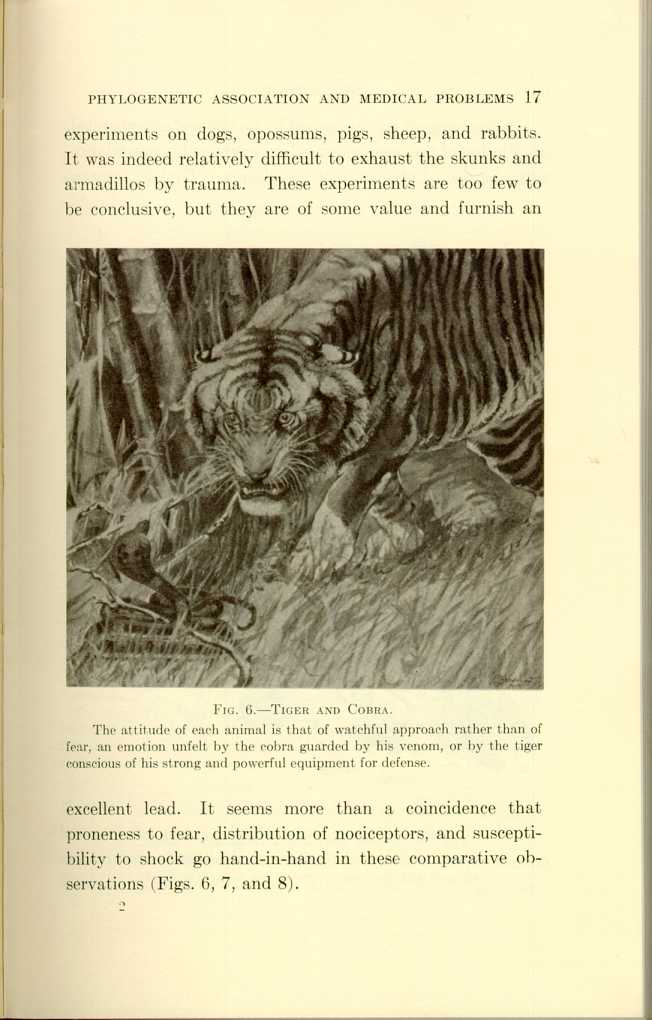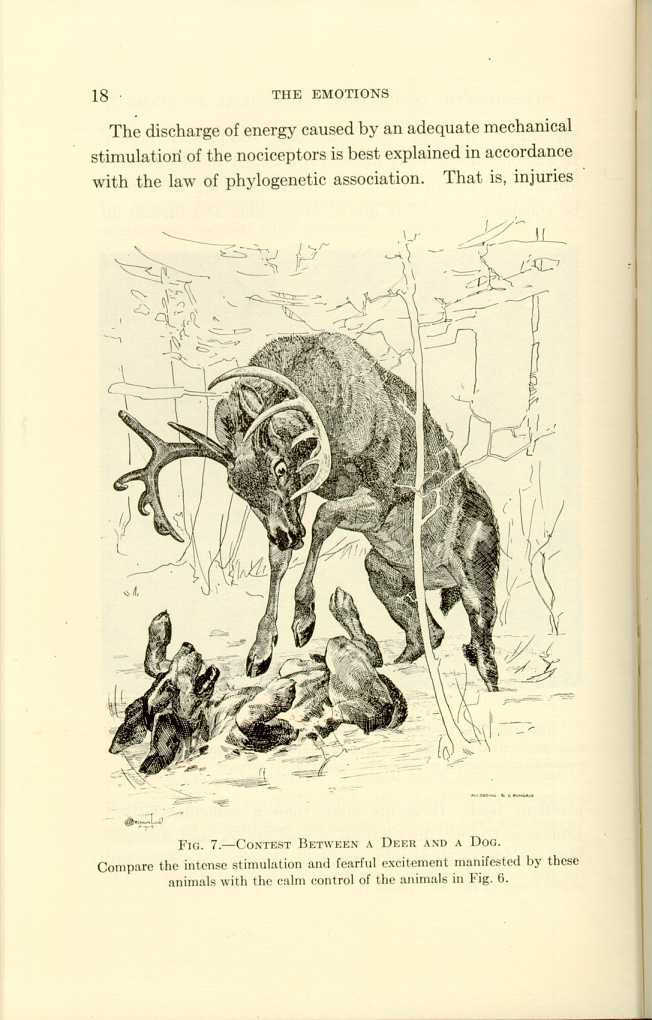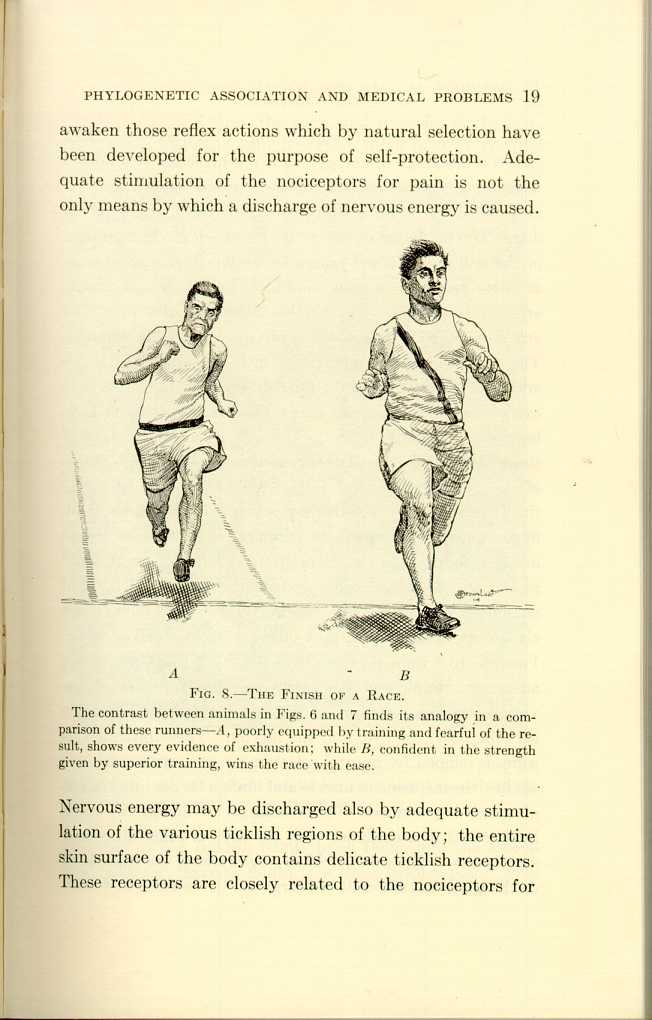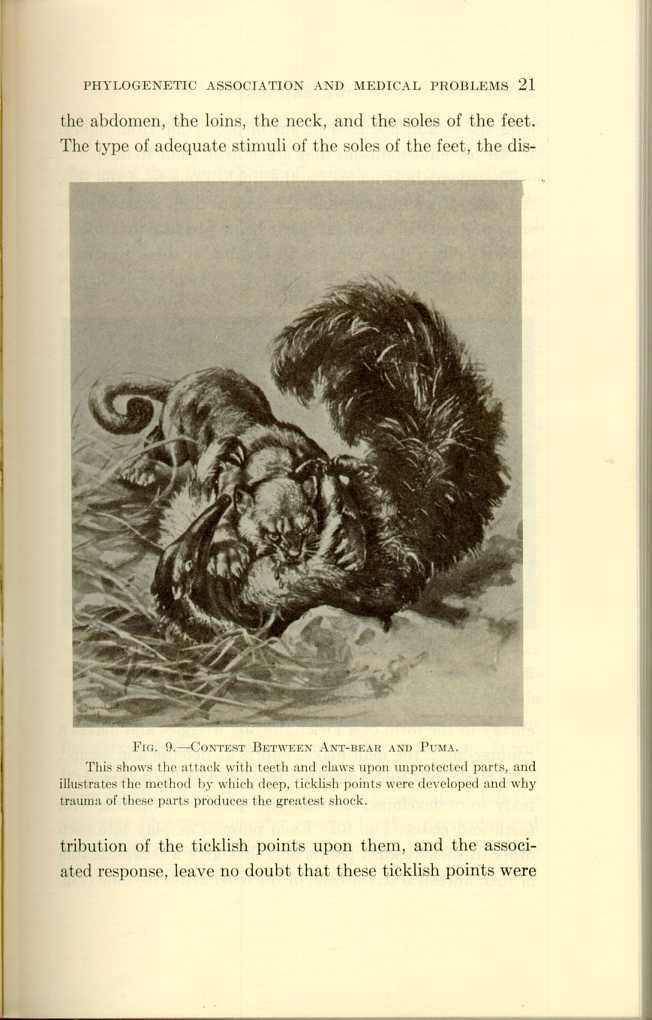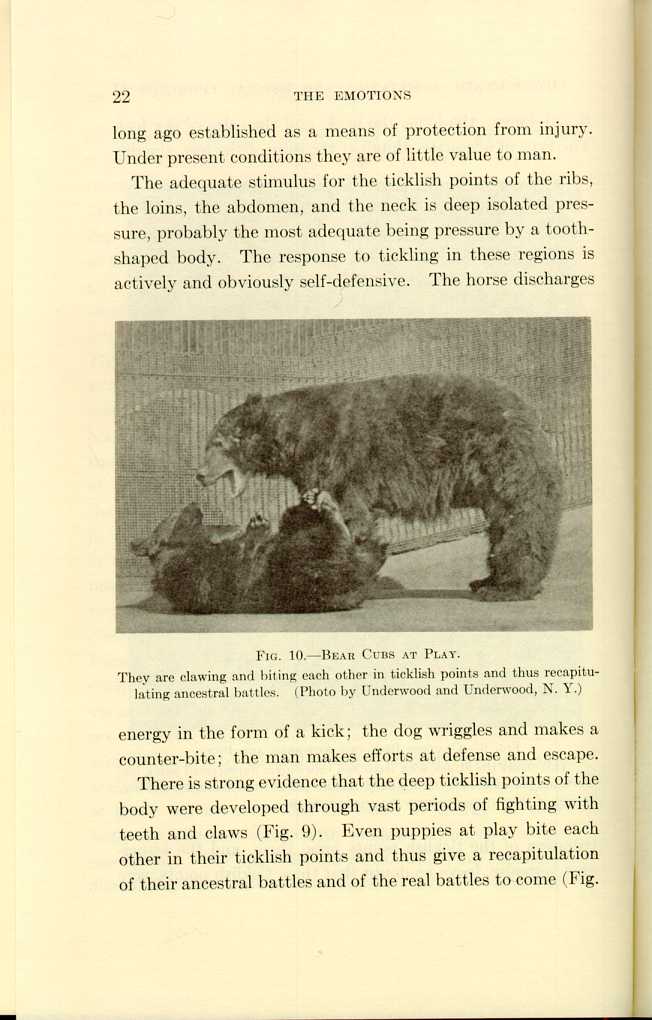The Cause of the Discharge of Nervous Energy as a Result of
Trauma under Inhalation Anesthesia and under Normal
Conditions
I looked into this problem from many viewpoints and there
seemed to be no solution until it occurred to me to seek the
explanation in certain of the postulates which make up the
doctrine of evolution. I realize fully the difficulty and the
danger in attempting to reach the generalization which I
shall make later and in the hypothesis I shall propose, for
there is, of course, no direct final proof of the truth of even
the doctrine of evolution. It is idle to consider any
experimental research into the cause of phenomena that have
developed by natural selection during millions of years.
Nature herself has made the experiments on a world-wide
scale and the data are before us for interpretation. Darwin
could do no more than to collect all available facts and
then to frame the hypothesis by which the facts were best
harmonized. Sherrington, that masterly physiologist, in
his volume entitled "The Integrative Action of the Nervous
System," shows clearly how the central nervous system was
built up in the process of evolution. Sherrington has made
free use of Darwin's doctrine in explaining physiologic
functions, just as anatomists have extensively utilized it
in the explanation of the genesis of anatomic forms. I
shall assume, therefore, that the discharge of nervous energy
is accomplished by the application of the laws of inheritance
and association, and I conclude that this hypothesis
will explain many clinical phenomena. I shall now present
such evidence in favor of this hypothesis as time and my
limitations will admit, after which I shall point out certain
clinical facts that may be explained by this hypothesis.
According to the doctrine of evolution, every function owes
its origin to natural selection in the struggle for existence.
In the lower and simpler forms of animal life, indeed, in our
human progenitors as well, existence depended principally
upon the success with which three great purposes were
achieved: (1) Self-defense against or escape from enemies;
(2) the acquisition of food; and (3) procreation; and these
were virtually the only purposes for which nervous energy
was discharged. In its last analysis, in a biologic sense, this
statement holds true of man today. Disregarding for the
present the expenditure of energy for procuring food and
for procreation, let us consider the discharge of energy for
self-preservation. The mechanisms for self-defense which
we now possess were developed in the course of vast periods
of time through innumerable intermediary stages from those
possessed by the lowest forms of life. One would suppose,
therefore, that we must now be in possession of mechanisms
which still discharge energy on adequate stimulation, but
which are not suited to our present needs. We shall point
out some examples of such unnecessary mechanisms. As
Sherrington has stated, our skin, in which are implanted
many receptors for receiving specific stimuli which are transmitted
to the brain, is interposed between ourselves and
the environment in which we are immersed. When these
stimuli reach the brain, there is a specific response, principally
in the form of muscular action. Now, each receptor
can be adequately stimulated only by the particular factor
or factors in the environment which created the necessity
for the existence of that receptor. Thus there have arisen
receptors for touch, for temperature, for pain, etc. The
receptors for pain have been designated
nociceptors (nocuous
or harmful) by Sherrington.
On the basis of natural selection, nociceptors could have
developed in only those regions of the body which have been
exposed to injury during long periods of time. On this
ground the finger, because it is exposed, should have many
nociceptors, while the brain, though the most important
organ of the body, should have no nociceptors because,
during a vast period of time, it has been protected by a skull.
Realizing that this point is a crucial one, Dr. Sloan and I
made a series of careful experiments. The cerebral hemispheres
of dogs were exposed by removing the skull and dura
under ether and local anesthesia. Then various portions
of the hemispheres were slowly but completely destroyed
by rubbing them with pieces of gauze. In some instances
a hemisphere was destroyed by burning. In no case was
there more than a slight response of the centers governing
circulation and respiration, and no morphologic change was
noted in an histologic study of the brain-cells of the
uninjured hemisphere. The experiment was as completely
negative as were the experiments on the "spinal dog."
Clinically I have confirmed these experimental findings
when I have explored the brains of conscious patients with
a probe to determine the presence of brain tumors. Such
explorations elicited neither pain nor any evidence of altered
physiologic functions. The brain, therefore, contains no
mechanism—no nociceptors—the direct stimulation of
which can cause a discharge of nervous energy in a
self-defensive action. That is to say, direct injury of the brain
can cause no purposeful nerve-muscular action, while direct
injury of the finger does cause purposeful nerve-muscular
action. In like manner, the deeper portions of the spinal
region have been sheltered from trauma and they, too, show
but little power of causing a discharge of nervous energy
on receiving trauma. The various tissues and organs of the
body are differently endowed with injury receptors—the
nociceptors of Sherrington. The abdomen and chest when
traumatized stand first in their facility for causing the discharge
of nervous energy,
i. e.,
they
stand first in shock production.
Then follow the extremities, the neck, and the back.
It is an interesting fact also that different types of trauma
elicit different responses as far as the consequent discharge
of energy is concerned.
Because it is such a commonplace observation, one scarcely
realizes the importance of the fact that clean-cut wounds
inflicted by a razor-like knife cause the least reaction, while
a tearing, crushing trauma causes the greatest response.
It is a suggestive fact that the greatest shock is produced
by any technic which imitates the methods of attack and of
slaughter used by the carnivora. In the course of evolution,
injuries thus produced may well have been the predominating
type of traumata to which our progenitors were subjected.
In one particular respect there is an analogy between the
response to trauma of some parts of the body of the individuals
of a species susceptible to shock and the response to
trauma of the individuals in certain other great divisions of
the animal kingdom. Natural selection has protected the
crustaceans against their enemies by protective armor,
e. g.,
the turtle and the armadillo; to the birds, it has given sharp
eyes and wings, as, for instance, the wild goose to another
species—the skunk—it has given a noisome odor for its
protection. The turtle, protected by its armor against
trauma, is in a very similar position to that of the sheltered
brain of man and, like the brain, the turtle does not respond
to trauma by an especially active self-protective
nerve-muscular response, but merely withdraws its head and legs
within the armored protection. It is proverbially difficult
to exhaust or to kill this animal by trauma. The brain and
other phylogenetically sheltered parts likewise give no exhausting
self-protective nerve-muscular response to trauma.
The skunk is quite effectively protected from violence by its
peculiar odor. This is indicated not only by the protective
value of the odor itself, but also by the fact that the skunk
has no efficient nerve-muscular mechanism for escape or
defense; it can neither run fast nor can it climb a tree.
Moreover, in encounters it shows no fear and backs rather
than runs. The armadillo rolls itself into a ball for defense.
On these premises we should conclude that the turtle, the
armadillo, and the skunk have fewer nociceptors than has
a dog or man, and that they would show less response to
trauma. In two carefully conducted experiments on skunks
and two on armadillos (an insufficient number) the energy
discharged in response to severe and protracted trauma of
the abdominal viscera was very much less than in similar
experiments on dogs, opossums, pigs, sheep, and rabbits.
It was indeed relatively difficult to exhaust the skunks and
armadillos by trauma. These experiments are too few to
be conclusive, but they are of some value and furnish an
excellent lead. It seems more than a coincidence that
proneness to fear, distribution of nociceptors, and susceptibility
to shock go hand-in-hand in these comparative observations
(Figs. 6, 7, and 8).
The discharge of energy caused by an adequate mechanical
stimulation of the nociceptors is best explained in accordance
with the law of phylogenetic association. That is, injuries
awaken those reflex actions which by natural selection have
been developed for the purpose of self-protection. Adequate
stimulation of the nociceptors for pain is not the
only means by which a discharge of nervous energy is caused.
Nervous energy may be discharged also by adequate stimulation
of the various ticklish regions of the body; the entire
skin surface of the body contains delicate ticklish receptors.
These receptors are closely related to the nociceptors for
pain, and their adequate stimulation by an insect-like touch
causes a discharge of energy,—a nerve-muscular
reaction,—resembling that developed for the purpose of brushing off
insects. This reflex is similar to the scratch reflex in the
dog. The discharge of energy is almost wholly independent
of the will and is a self-protective action in the same sense
as is the response to pain stimuli. The ear in man and in
animals is acutely ticklish, the adequate stimulus being
any foreign body, especially a buzzing, insect-like contact.
The discharge of nervous energy in horses and in cattle on
adequate stimulation of the ticklish receptors of the ear is so
extraordinary that in the course of evolution it must have
been of great importance to the safety of the animal. A
similar ticklish zone guards the nasal chambers, the discharge
of energy here taking a form which effectively dislodges
the foreign body. The larynx is exquisitely ticklish, and,
in response to any adequate stimulus, energy is discharged
in the production of a vigorous cough. The mouth and
pharynx have active receptors which cause the rejection of
noxious substances. The conjunctival reflex, though not
classed as ticklish, is a most efficient self-protective reflex.
I assume that there is no doubt as to the relation between the
adequate stimuli and the nerve-muscular response of the
various ticklish receptors of the surface of the skin, of the
ear, the nose, the eye, and the larynx. These mechanisms
were developed by natural selection as protective measures
against the intrusion of insects and foreign bodies into regions
of great importance. The discharge of energy in these
instances is in accordance with the laws of inheritance and
association. The other ticklish points which are capable of
discharging vast amounts of energy are the lateral chest-wall,
the abdomen, the loins, the neck, and the soles of the feet.
The type of adequate stimuli of the soles of the feet, the
distribution
of the ticklish points upon them, and the associated
response, leave no doubt that these ticklish points were
long ago established as a means of protection from injury.
Under present conditions they are of little value to man.
The adequate stimulus for the ticklish points of the ribs,
the loins, the abdomen, and the neck is deep isolated pressure,
probably the most adequate being pressure by a
tooth-shaped body. The response to tickling in these regions is
actively and obviously self-defensive. The horse discharges
energy in the form of a kick; the dog wriggles and makes a
counter-bite; the man makes efforts at defense and escape.
There is strong evidence that the deep ticklish points of the
body were developed through vast periods of fighting with
teeth and claws (Fig. 9). Even puppies at play bite each
other in their ticklish points and thus give a recapitulation
of their ancestral battles and of the real battles to come (Fig.
10). The mere fact that animals fight effectively in the dark
and always according to the habit of their species supports
the belief that the fighting of animals is not an intellectual
but a reflex process. There are no rules which govern the
conduct of a fight between animals. The events follow each
other with such kaleidoscopic rapidity that the process is
but a series of automatic stimulations and physiologic reactions.
Whatever their significance, therefore, it is certain
that man did not come either accidentally or without purpose
into possession of the deep ticklish regions of his chest and
abdomen. Should any one doubt the vast power that adequate
stimulation of these regions possesses in causing the
discharge of energy, let him be bound hand and foot and
vigorously tickled for an hour. What would happen? He
would be as completely exhausted as though he had experienced
a major surgical operation or had run a Marathon race.
A close analogy to the reflex process in the fighting of
animals is shown in the rôle played by the sexual receptors
in conjugation. Adequate stimulation of either of these two
distinct groups of receptors, the sexual and the noci, causes
specific behavior—the one toward embrace, the other toward
repulsion. Again, one of the most peremptory causes
of the discharge of energy is that due to an attempt to obstruct
forcibly the mouth and the nose so that asphyxia
is threatened. Under such conditions neither friend nor
foe is trusted, and a desperate struggle for air ensues. It will
be readily granted that the reactions to prevent suffocation
were established for the purpose of self-preservation, but the
discharge of nerve-muscular energy to this particular end
is no more specific and no more shows adaptive qualities
than do the preceding examples. Even the proposal to bind
one down hand and foot excites resentment, a feeling originally
suggested by the need for self-preservation. No patient
views with equanimity the application of shackles as a
preparation for anesthesia.
We have now considered some of the causes of those discharges
of nervous energy which result from various types
of harmful physical contact, and have referred to the analogous,
though antithetical, response to the stimulation of the
sexual receptors. The response to the adequate stimuli
of each of the several receptors is a discharge of
nerve-muscular energy of a specific type; that is, there is one type
of response for the ear, one for the larynx, one for the pharynx,
another for the nose, another for the eye, another for the
deep ticklish points of the chest and the abdomen, quite
another for the delicate tickling of the skin, and still another
type of response to sexual stimuli.
According to Sherrington, a given receptor has a low
threshold for only one, its own specific stimulus, and a high
threshold for all others; that is, the doors that guard the
nerve-paths to the brain are opened only when the proper
password is received. According to Sherrington's law, the
individual as a whole responds to but one stimulus at a
time, that is, only one stimulus occupies the nerve-paths
which carry the impulses as a result of which acts are performed,
i. e., the final common path. As soon as a stronger
stimulus reaches the brain it dispossesses whatever other
stimulus is then occupying the final common path—the path
of action. The various receptors have a definite order of
precedence over each other (Sherrington). For example,
the impulse from the delicate ticklish points of the skin,
whose adequate stimulus is an insect-like contact, could not
successfully compete for the final common path with the
stimulus of a nociceptor. The stimulus of a fly on the nose
would be at once superseded by the crushing of a finger.
In quick succession do the various receptors (Sherrington)
occupy the final common path, but each stimulus is for the
time the sole possessor, hence the nervous system is integrated
(connected) to act as a whole. Each individual at
every moment of life has a limited amount of dischargeable
nervous energy. This energy is at the disposal of any
stimulus that obtains possession of the final common path,
and results in the performance of an act. Each discharge
of energy is subtracted from the sum total of stored energy
and, whether the subtractions are made by the excitation of
nociceptors by trauma, by tickling, by fighting, by fear, by
flight, or by the excitation of sexual receptors, by any of
these singly or in combination with others, the sum total
of the expenditure of energy, if large enough, produces
exhaustion. Apparently there is no distinction between that
state of exhaustion which is due to the discharge of nervous
energy in response to trauma and that due to other causes.
The manner of the discharge of energy is specific for each
type of stimulation. On this conception, traumatic shock
takes its place as a natural phenomenon and is divested of
its mask of mystery.
